Effective Strategies to Deter Woodpeckers from Homes
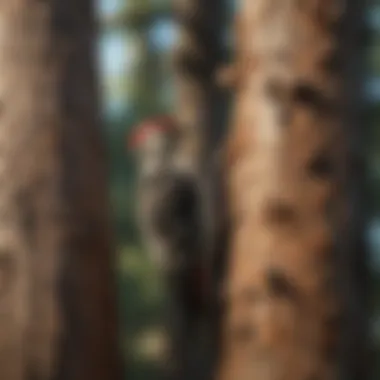
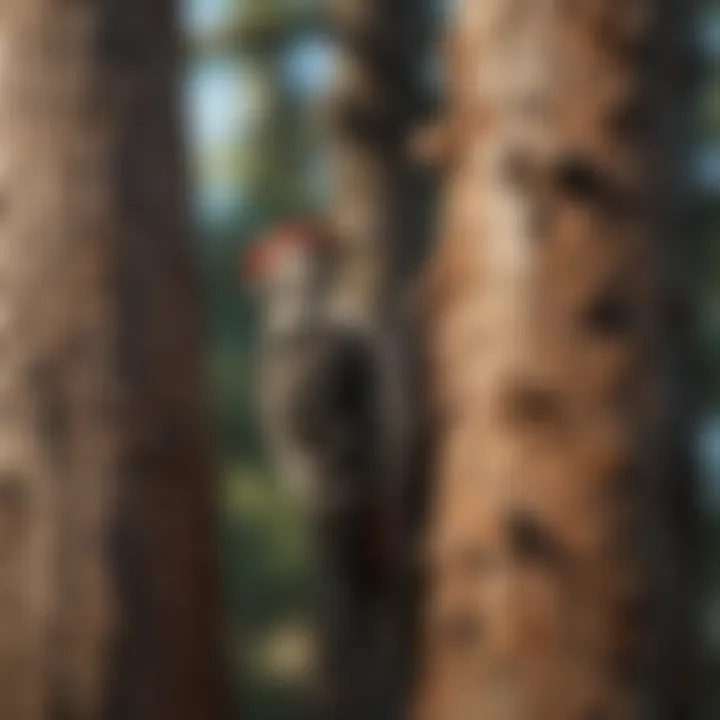
Intro
Woodpeckers can be charming birds in their natural habitat, but their presence near residential areas often leads to frustration for homeowners. These birds can cause significant damage to the exterior of houses, particularly siding, eaves, and wooden structures. Understanding the behaviors and habits of woodpeckers is essential for implementing effective strategies to keep them away.
Effective management begins with identifying the specific woodpecker species that may be causing issues. This knowledge allows homeowners to better understand their habits and preferences. Additionally, taking preemptive steps can minimize the likelihood of unwanted interactions with these birds. This article aims to provide practical insights and actionable solutions for homeowners seeking to protect their property from woodpecker damage.
Pest Identification
Common Woodpecker Species
In North America, several woodpecker species are known to cause problems for homeowners. The most common include the Downy Woodpecker, Hairy Woodpecker, and the Northern Flicker. Each of these species displays different behaviors and preferences regarding nesting and foraging, which can lead them to residential areas.
- Downy Woodpecker: Small and often found in orchards or gardens. They typically make small holes, primarily in search of insects.
- Hairy Woodpecker: Slightly larger than their Downy relatives, they can be identified by their more pronounced markings. They drill into wood for food and can cause notable damage.
- Northern Flicker: Known for their distinct call and ground foraging behavior, they can also drill into wooden structures for nesting.
Signs and Symptoms of Infestations
Recognizing the signs of woodpecker activity is critical for early intervention. Homeowners should be vigilant for the following indicators:
- Damage: Small holes or larger excavations visible on the exterior surfaces of the house.
- Drumming Sounds: Woodpeckers often drum on surfaces as part of their mating rituals or to establish territory. An increase in these sounds may suggest that they are nearby.
- Feathers or Droppings: Closer inspection may reveal feathers or droppings which can indicate nesting.
Prevention Strategies
Taking preventive actions is essential in deterring woodpeckers from causing damage to your home. Below are some effective strategies.
Home Maintenance Tips for Pest Prevention
- Seal Openings: Check for and seal any holes or gaps in siding or eaves. Most woodpeckers are searching for insect larvae to consume or creating a nesting site.
- Repair Damage: Address any existing damage to wooden surfaces promptly. Wood that is already compromised can attract woodpeckers seeking easy access to food or nesting sites.
- Choose Right Materials: Consider using metal or vinyl siding instead of wood when possible. These materials are less appealing to woodpeckers.
Natural Deterrents and Barriers
Several natural solutions can help dissuade woodpeckers from your home:
- Visual Deterrents: Hanging reflective tape, shiny objects, or even predator decoys can frighten woodpeckers away.
- Sound Devices: Devices that emit noise or mimic predator sounds may help in keeping them at bay.
- Netting: Installing mesh netting or bird spikes around areas prone to woodpecker activity can act as a physical barrier to entry.
Treatment Options
If preventative measures fail and woodpeckers still cause damage, it is important to have effective treatment options available.
Overview of Chemical vs. Natural Treatments
- Natural Treatments: Solutions such as applying a combination of vinegar and water can deter woodpeckers due to the unpleasant smell. It is safe and non-toxic.
- Chemical Treatments: Pesticides or repellents specifically designed for avian pests may also be an option, but careful consideration should be given to local regulations and environmental impact.
Step-by-Step Guides for DIY Treatments
- Identify Damage Areas: Walk around your house and locate all the areas where woodpeckers have caused damage.
- Clean the Area: Remove any debris and clean the area with a mixture of vinegar to deter future activity.
- Apply Deterrents: Implement visual or sound deterrents in locations observed to be affected.
- Monitor Progress: Over the next few weeks, observe the areas for signs of continued woodpecker activity, adjusting your methods as necessary.
It's often more effective to combine multiple deterrent strategies to achieve the best results.
Understanding Woodpecker Behavior
Understanding woodpecker behavior is essential for any homeowner facing the challenge of these birds. Woodpeckers are often drawn to residential structures for various reasons. Gaining insights into their habits and motivations can facilitate better prevention strategies. By knowing why woodpeckers behave in certain ways, homeowners can make informed decisions on how to deter them effectively. This section covers the general habits of woodpeckers, identifies species commonly seen around homes, and explains why they may choose to drill into human structures.
General Habits of Woodpeckers
Woodpeckers are unique birds, recognized by their sharp bills and drumming sounds. They usually forage for insects, primarily insects that live under bark. They also drill into trees to create nesting sites. Most woodpeckers are territorial. They often announce their presence with loud drumming, which acts as a signal to other woodpeckers. This means that if woodpeckers are drumming on your house, it might be a communication method rather than solely about finding food.
These birds also tend to follow seasonal patterns. In spring, they are most active in seeking mates and establishing breeding territories. Fall and winter may see less activity, but they can still cause issues if they are establishing a winter roost.
Common Species That Target Homes
Several species of woodpeckers commonly create problems for homeowners. Some of the most prevalent include:
- Downy Woodpecker: Typically small and easily recognizable by their black-and-white plumage.
- Hairy Woodpecker: Larger and similar in appearance to the downy but with a longer bill.
- Northern Flicker: Known for their distinctive markings and a tendency to forage on the ground.
- Red-Bellied Woodpecker: Easily identified by their unique coloration and frequent visits to feeders.
These woodpecker species can inflict damage to homes, particularly on wooden siding or roofs. Understanding which species are present around your property can help tailor prevention methods.
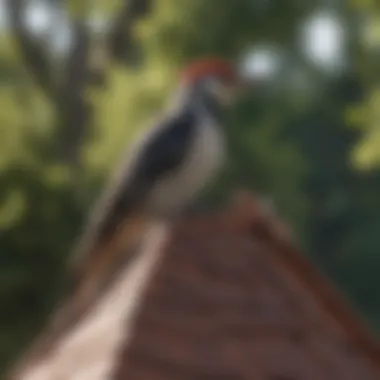
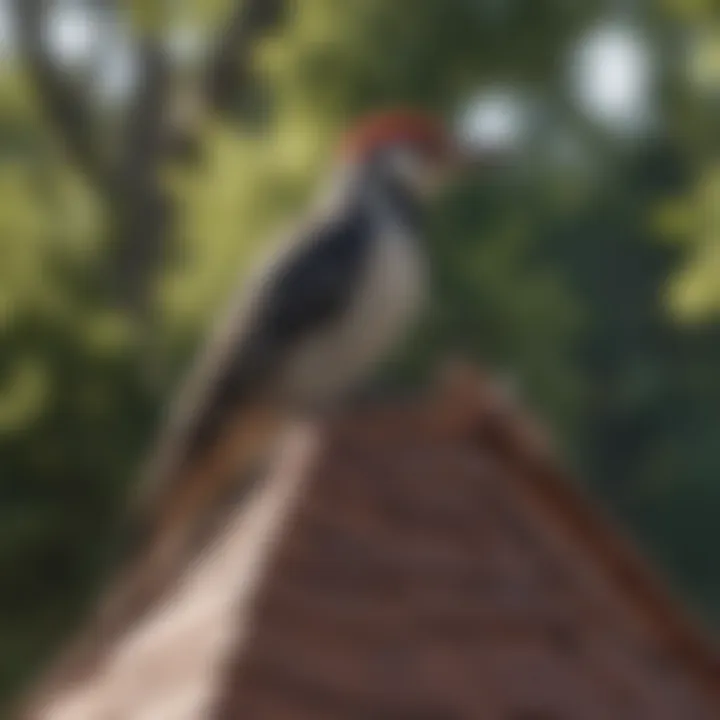
Why Woodpeckers Drill Into Homes
Woodpeckers drill into homes for several reasons. Firstly, they may search for insects hidden in the wood. If your house has wood damaged by moisture or pests, this can attract woodpeckers.
Secondly, woodpeckers may be looking for a suitable nesting site. The sound of drilling can also be a method to communicate or establish territory, particularly during mating season. Understanding these motivations is key to addressing the problem effectively.
"If you notice woodpeckers regularly drilling into your house, it may indicate a larger issue with your home’s structure or pest presence."
Recognizing these behaviors can inform your strategy in keeping woodpeckers away. By understanding their habits, homeowners can take efficient steps to minimize the attraction to their properties.
Identifying Problem Areas Around Your House
Identifying problem areas around your home is crucial when attempting to deter woodpeckers. These areas often serve as hotspots for their activity. When homeowners can recognize and address these sections, they can significantly reduce the chances of woodpeckers causing damage. Understanding where woodpeckers are likely to gather and drill can help you formulate effective strategies. Moreover, taking time to examine your home can provide insights into how to limit inviting conditions for these birds.
Examining At-Risk Sections of Your Home
Woodpeckers tend to target specific areas of houses and buildings. Commonly at risk are wooden siding, eaves, and fences. If your home has wood elements, it is essential to inspect these areas regularly. Look for any evidence that woodpeckers are showing interest.
Consider checking:
- Siding: Woodpeckers like the texture of wood. Their drilling can leave small holes or marks on the surface.
- Eaves: These areas often provide a convenient spot for woodpeckers to perch and drill.
- Fences: Wooden fences can also attract woodpeckers, especially those with old wood or visible insect infestations.
Pay attention to these sections during different times of the year, as woodpeckers may be more active at certain seasons.
Signs of Woodpecker Damage
Detecting signs of woodpecker damage early can prevent more severe problems later. Common signs include:
- Holes: Small holes that appear on wooden surfaces are a clear signal of woodpecker activity. The holes can vary in size, depending on the species.
- Chipped Paint: If you observe paint peeling or chipping around a specific area, it could be due to woodpeckers pecking at the surface.
- Drumming Sounds: Often, you can hear the drumming sounds that woodpeckers make when they are active. Identify these noises during the day, as they often signify nearby activity.
Monitoring these signs will assist you in pinpointing areas of concern and responding appropriately.
Seasonal Patterns in Woodpecker Activity
Woodpecker activity is not consistent throughout the year and tends to vary by season. Recognizing these patterns can inform homeowners about the best times to undertake preventative measures. Typically, woodpecker activity increases during the spring and early summer as they engage in breeding. During this time, they may be more likely to establish territory and drum on hard surfaces, including your home.
In contrast, the autumn and winter months may see decreased activity, as they seek shelter and food. However, homes that offer hidden corners or food sources can still attract them during these quieter periods.
Awareness of these seasonal behaviors allows you to adjust your defense strategies accordingly. Taking early action can lead to a more successful and lasting resolution to the issue of woodpecker disturbances.
Deterring Woodpeckers Effectively
Woodpeckers can cause significant damage to homes, leading homeowners to seek effective strategies for deterrence. Deterring woodpeckers not only safeguards your property but also maintains its aesthetic appeal. Implementing effective deterrence methods can prevent further damage. This section will cover visual, auditory, and physical deterrents to keep woodpeckers at bay. Understanding these strategies provides a foundation for protecting your home with practical solutions.
Visual Deterrents
Visual deterrents are an essential part of keeping woodpeckers away from your house. These methods use sight to discourage birds from approaching. They create an unsettling environment for woodpeckers, making your home less appealing.
Reflective Objects
Reflective objects serve as a simple yet effective visual deterrent against woodpeckers. Their shiny surfaces reflect sunlight, creating bright glimmers that can startle birds. This characteristic makes them a popular choice for homeowners.
Some common reflective objects include old CDs, aluminum foil, or reflective tape. These items are easily available and inexpensive. The unique feature is they are not permanent fixtures, allowing flexibility for placement. However, one disadvantage is that if they lose their reflective quality or are not placed correctly, they may become less effective over time.
Decoys and Fake Predators
Decoys and fake predators can also be powerful visual deterrents. By mimicking birds of prey, homeowners can create an environment that feels dangerous to woodpeckers. The presence of a decoy may discourage them from approaching your home.
Common decoys include owls or hawks, which can often be found at garden stores. Their key characteristic is that they often have realistic features, which enhances their effectiveness. Advantages include low maintenance and the option to reposition them for better results. On the flip side, decoys can lose their effectiveness if woodpeckers become accustomed to their presence.
Auditory Deterrents
Auditory deterrents can effectively dissuade woodpeckers from targeting homes. These devices leverage sound to make the environment less welcoming. Incorporating noise into your strategy can enhance the effectiveness of other methods.
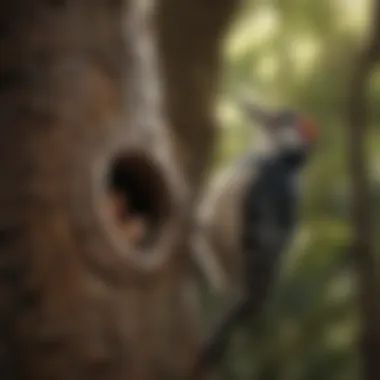
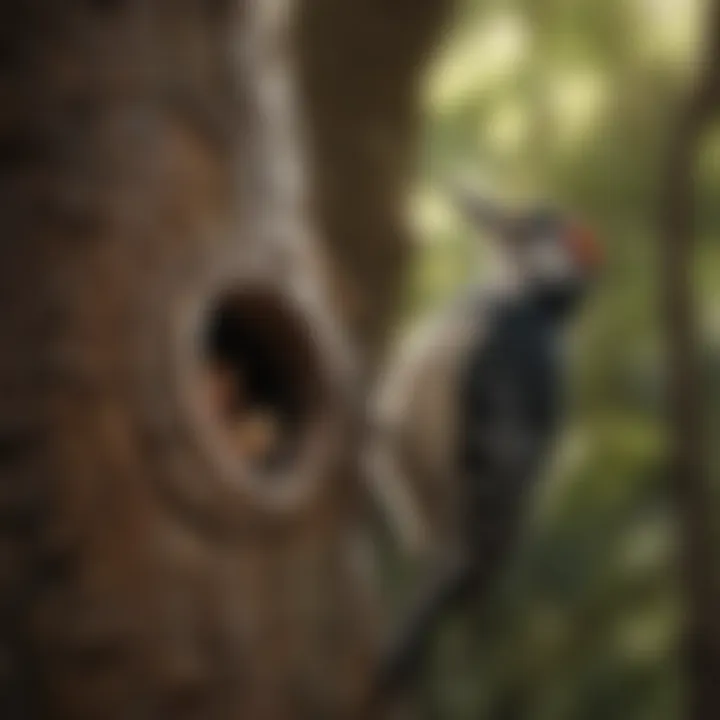
Noise-Making Devices
Noise-making devices produce sudden, loud sounds that can startle and scare woodpeckers away. These devices range from wind chimes to more advanced noisemakers that emit bursts of sound at random intervals. The key characteristic of these devices is unpredictability in noise production, which confuses the birds and keeps them at bay.
They are a popular choice because they often can be installed easily. However, one challenge is the potential for noise pollution, impacting not only woodpeckers but also the humans in surrounding areas.
Sound Repellents
Sound repellents are devices engineered to emit specific frequencies that are unpleasant for woodpeckers. Such devices can be more sophisticated and are designed to target the hearing range of birds effectively. Their main feature is that they produce sounds that humans generally cannot hear, making them discreet for homeowners.
The advantage of sound repellents is that they can be automated, providing a continuous deterrent. However, these devices may require an initial investment, making them less favorable for some homeowners.
Physical Barriers
Physical barriers are a reliable way to prevent woodpeckers from accessing your home. By creating obstacles, you can physically block woodpeckers from drilling into your exterior.
Netting and Mesh Screens
Netting and mesh screens can efficiently deter woodpeckers from landing on or pecking at specific areas. These products are designed to be durable and can withstand outdoor conditions. Their key characteristic is their ability to tightly cover vulnerable spots, making it difficult for woodpeckers to reach the wood underneath.
These barriers are beneficial as they allow airflow and sunlight while protecting your home. A downside, however, is that installing these items may require more effort and may alter the appearance of your house slightly.
Woodpecker-Proofing Materials
Woodpecker-proofing materials, like specialized siding or roofing, provide lasting protection against woodpecker damage. These materials are often constructed to resist pecking, which contributes significantly to the goal of deterrence. Their key feature is their robustness, designed explicitly to withstand woodpecker behavior.
These materials are popular as they offer a permanent solution for long-term homeowners. Yet, the main drawback includes higher costs, making it less appealing for those on a budget.
Implementing a combination of visual, auditory, and physical methods creates a more effective deterrent system. Consider using several strategies together for the best results.
Maintenance Practices to Minimize Attraction
Maintaining your property plays a critical role in discouraging woodpeckers from visiting. These practices not only safeguard your home but also improve its overall aesthetic and functionality. Minimizing attractants and maintaining your property properly creates a less appealing environment for woodpeckers. This section discusses various maintenance practices that homeowners can implement to reduce the likelihood of woodpecker activity around their homes.
Regular Inspection
Regular inspections of your property are essential for identifying any damages or potential attractants that might draw woodpeckers. Checking the exterior of your house, especially areas that are susceptible to woodpecker damage, such as siding, soffits, and eaves, helps catch problems early.
During these inspections, look for signs of woodpecker activity, such as drilling holes or pecked areas. It is also important to examine wooden structures and fences for damage. By being proactive, homeowners can address these issues promptly, thereby reducing the chances of ongoing woodpecker presence.
Proper Landscaping Techniques
Landscaping significantly impacts woodpecker activity around your home. Implementing thoughtful landscaping techniques can help manage the surrounding environment, making it less appealing to these birds.
Choosing Appropriate Plants
Choosing appropriate plants involves selecting species that are less attractive to woodpeckers. Plants that produce heavy nuts and seeds can attract woodpeckers seeking food. It is wise to opt for trees and shrubs that do not provide such resources or are less appealing.
Some excellent choices include:
- Flowering Dogwood: This tree produces flowers instead of hard seeds.
- Japanese Maple: Its foliage is non-attractive to woodpeckers.
- Ornamental Grasses: They add beauty without providing woodpeckers a food source.
Choosing these plants minimizes attraction, which is essential for deterring woodpeckers.
Managing Natural Food Sources
Managing natural food sources is a key aspect of keeping woodpeckers at bay. If you have fruit trees, they can draw woodpeckers, especially if the fruit is past ripe. Regularly harvesting fruits and maintaining the tree health are important steps in management.
Additionally, consider:
- Adding Netting: Use bird netting on fruit trees to prevent access for woodpeckers.
- Removing Dead Trees: These can serve as food sources if they harbor insects.
- Maintaining Bird Feeders: If you have bird feeders, ensure they do not become a food source for woodpeckers by using types that are not appealing to them.
By effectively managing these sources, you limit the natural food supply that attracts woodpeckers, fostering a more woodpecker-friendly environment.
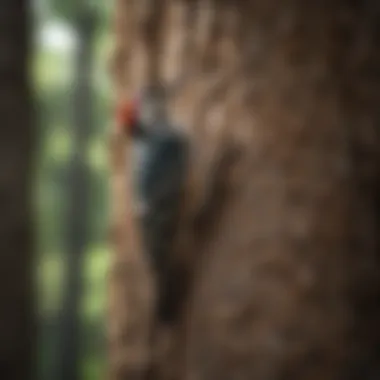
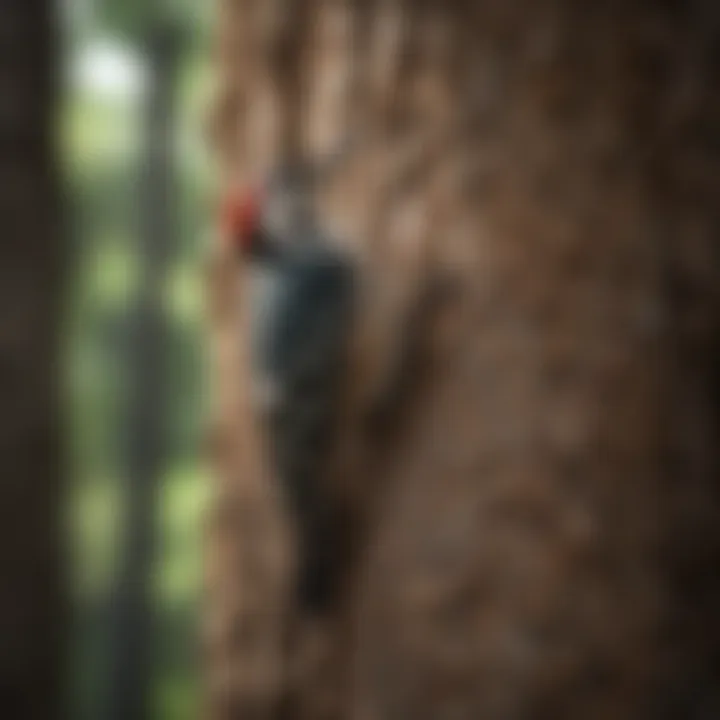
Dealing with Existing Damage
Dealing with existing damage should be another priority in your maintenance efforts. After identifying areas of damage from woodpeckers, it is vital to repair these spots quickly. Not only does it maintain your home's curb appeal, but it also discourages further drilling.
When repairing damage, consider:
- Using Strong Materials: Choose durable, woodpecker-proof materials for repairs.
- Covering Holes: Fill drilled holes to deter future visits.
Ultimately, maintaining and repairing your property plays a significant part in keeping woodpeckers away. It enhances your home's appearance while minimizing the risk of future activities by these birds.
Legal Considerations in Woodpecker Management
Addressing woodpecker management involves crucial legal factors. Homeowners must recognize that many birds, including woodpeckers, are protected by law in various jurisdictions. These regulations often stem from the need to conserve wildlife and biodiversity. Ignoring these legal stipulations could lead to serious fines or legal repercussions. Understanding the nuances of wildlife protection laws is essential for anyone seeking to manage woodpecker problems responsibly and effectively.
Understanding Wildlife Protection Laws
Wildlife protection laws differ widely from one location to another. In the United States, for example, the Migratory Bird Treaty Act makes it illegal to harm or kill migratory birds without a permit. Woodpeckers, as migratory birds, are thus covered under this act. Homeowners should always check their local laws or consult with environmental agencies to be well-informed.
The consequences of infringing these laws can be significant. Not only could one face legal action, but violating such laws can result in environmental harm as well. Therefore, it is vital to be aware of the legislation regarding woodpecker management before taking any action against them.
Ethical Methods of Deterrence
Employing ethical measures for deterring woodpeckers is not only a legal necessity but also a moral responsibility. Here are some effective options:
- Visual deterrents: Sliver reflective tapes, shiny objects, or decoys can dissuade woodpeckers from approaching.
- Non-invasive sound devices: Using noise-making devices that mimic predators or startling sounds can help in keeping woodpeckers at bay.
- Habitat modification: Altering an environment to make it less appealing to woodpeckers is an ethical choice. This could include removing dead trees or pest infestations that might attract them.
Adopting these methods aligns with both legal requirements and ethical considerations. It is an opportunity to resolve conflicts with wildlife in a responsible manner. When homeowners take proactive but humane actions, they benefit from a well-maintained home without compromising the local ecosystem.
When to Seek Professional Help
Homeowners sometimes feel overwhelmed when dealing with woodpecker infestations. These birds, while fascinating, can cause considerable damage. Understanding when to call in an expert can save time and prevent further destruction.
Evaluating the Extent of Infestation
It is crucial to assess the situation before taking action. A minor issue might be manageable using simple deterrents. However, if you notice multiple holes or continuous pecking, it might mean a larger problem. Check the areas around your home thoroughly. Look for signs like fresh wood shavings or consistent noise from drilling. If problems are pervasive, it often signals that woodpeckers are not merely passing through but have made your house a target.
In such cases, consider the following steps:
- Document Findings: Note locations of damage and the type of pecking observed. This will help when discussing the problem with professionals.
- Monitor Activity: Watch for active times. Woodpeckers have specific habits, often pecking more in early morning hours.
- Evaluate Damage Cost: Consider how much repair will cost if left untreated. Extensive damage could lead to structural issues requiring a professional repair service.
Finding a Qualified Pest Control Service
When the decision is made to seek professional help, the next step is to find a reliable pest control service. Not all pest control companies deal with avian pests effectively. Focus on these criteria while searching:
- Experience with Woodpeckers: Select services that specialize in avian pest control. Ask about their previous experience and success rates with woodpecker situations.
- Methods Used: Enquire about their strategies. Companies should use humane and legal methods of deterrence. Be wary of approaches that cause harm to the birds or violate laws.
- Reviews and Referrals: Look for customer feedback. Check online platforms or ask neighbors for recommendations. Reliable reviews can provide insight into a service’s efficacy.
- Cost Estimates: Obtain several quotes. This will help you understand average costs and avoid overpriced services.
Ultimately, professional advice can streamline the process and promote a safe, long-term solution to your woodpecker problem.
"Professional intervention may seem like an additional cost, but preventing significant damage ensures your home remains safe and intact."
thorough assessments and qualified services can lead to strategies that protect your space effectively.
Culmination
The conclusion of this article serves as a vital reinforcement of the strategies discussed throughout the sections. It brings together the various approaches and insights aimed at keeping woodpeckers away from your home. Understanding woodpecker behavior is paramount. It enables homeowners to tailor their deterrent methods effectively. Recognizing that each woodpecker species may exhibit specific patterns can inform the choice of strategies.
Summarizing Effective Strategies
To summarize, it is essential to apply a mix of visual and auditory deterrents combined with physical barriers.
- Visual Deterrents: Using reflective objects and decoys can effectively disrupt woodpecker approaches. Birds often avoid areas that confuse their sight, which can include shiny surfaces or fake predators like owls.
- Auditory Deterrents: Noise-making devices and sound repellents serve as further protective layers. They can scare away birds, thus minimizing chances of damage.
- Physical Barriers: Employing netting and specific woodpecker-proof materials is a concrete step to prevent access to vulnerable areas like eaves and siding.
These strategies, when implemented consistently, can reduce the likelihood of woodpeckers causing damage to residential structures.
Encouraging Preventative Measures
Preventative measures are more effective than reactive solutions. Some practices to encourage include:
- Regular Maintenance: Frequent inspection of your home can help identify signs of potential woodpecker activity before it escalates.
- Smart Landscaping: Carefully selecting plants and managing food sources can deter woodpeckers from frequenting your property. Avoid attracting their food sources close to your home, such as dead trees.
- Dealing with Damage Promptly: Address any existing wood damage quickly. If woodpeckers perceive an access point, they are more likely to return.
By adopting these strategies and maintaining vigilance, homeowners can successfully protect their property from woodpeckers. This holistic approach not only safeguards structures but also encourages a harmonious coexistence with local wildlife.



